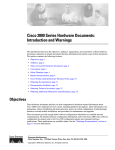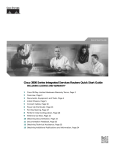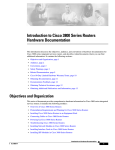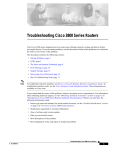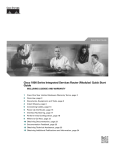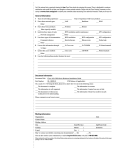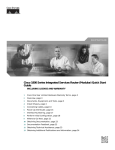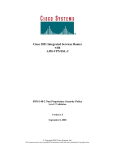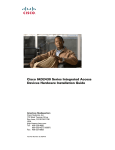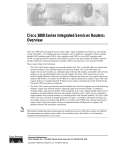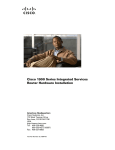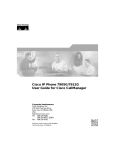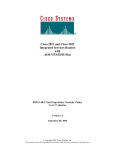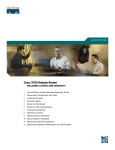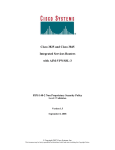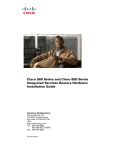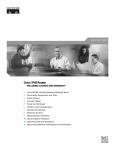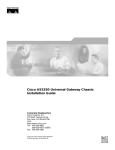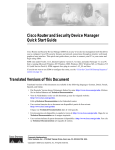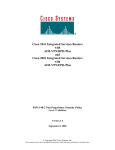Download Cisco Systems 2800 Network Router User Manual
Transcript
Quick Start Guide Cisco 2800 Series Integrated Services Routers Quick Start Guide INCLUDING LICENSE AND WARRANTY 1 Cisco 90-Day Limited Hardware Warranty Terms 2 Overview 3 Documents, Equipment, and Tools 4 Install Chassis 5 Connect Cables 6 Power Up the Router 7 Interface Numbering 8 Perform Initial Configuration 9 Where to Go Next 10 Obtaining Documentation 11 Documentation Feedback 12 Cisco Product Security Overview 13 Obtaining Technical Assistance 14 Obtaining Additional Publications and Information Revised: October 11, 2005, 78-16015-07 1 Cisco 90-Day Limited Hardware Warranty Terms There are special terms applicable to your hardware warranty and various services that you can use during the warranty period. Your formal Warranty Statement, including the warranties and license agreements applicable to Cisco software, is available on Cisco.com. Follow these steps to access and download the Cisco Information Packet and your warranty and license agreements from Cisco.com. 1. Launch your browser, and go to this URL: http://www.cisco.com/univercd/cc/td/doc/es_inpck/cetrans.htm The Warranties and License Agreements page appears. 2. To read the Cisco Information Packet, follow these steps: a. Click the Information Packet Number field, and make sure that the part number 78-5235-03A0 is highlighted. b. Select the language in which you would like to read the document. c. Click Go. The Cisco Limited Warranty and Software License page from the Information Packet appears. d. Read the document online, or click the PDF icon to download and print the document in Adobe Portable Document Format (PDF). Note You must have Adobe Acrobat Reader to view and print PDF files. You can download the reader from Adobe’s website, http://www.adobe.com. 3. To read translated and localized warranty information about your product, follow these steps: a. Enter this part number in the Warranty Document Number field: 78-5236-01C0 b. Select the language in which you would like to read the document. c. Click Go. The Cisco warranty page appears. d. Review the document online, or click the PDF icon to download and print the document in Adobe Portable Document Format (PDF). You can also contact the Cisco service and support website for assistance: http://www.cisco.com/en/US/support/ Duration of Hardware Warranty Ninety (90) days. Replacement, Repair, or Refund Policy for Hardware Cisco or its service center will use commercially reasonable efforts to ship a replacement part within ten (10) working days after receipt of a Return Materials Authorization (RMA) request. Actual delivery times can vary, depending on the customer location. Cisco reserves the right to refund the purchase price as its exclusive warranty remedy. 2 To Receive a Return Materials Authorization (RMA) Number Contact the company from whom you purchased the product. If you purchased the product directly from Cisco, contact your Cisco Sales and Service Representative. Complete the information below, and keep it for reference: Company product purchased from Company telephone number Product model number Product serial number Maintenance contract number 2 Overview The Cisco 2800 series integrated services routers include the Cisco 2801, Cisco 2811, Cisco 2821, and Cisco 2851 routers. These routers differ as follows: • Cisco 2801 routers support 2 HWIC/WIC/VIC/VWIC slots capable of supporting double-wide HWICs, 1 WIC/VWIC/VIC slot, 1 VWIC/VIC (voice only) slot, 2 advanced integration modules (AIM), 2 packet voice data modules (PVDMs), 2 Fast Ethernet connections, and 16 ports of IP phone power output. • Cisco 2811 routers support 1 single network module enhanced (NME), 4 single or 2 double high-speed WAN interface cards (HWICs), 2 AIMs, 2 packet voice data modules (PVDMs), 2 Fast Ethernet connections, and 24 ports of IP phone power output. • In Cisco 2821 routers, the network module slot adds support for a single network module enhanced extended (NME-X), and an additional slot supports an extension voice module (EVM); 3 PVDMs are supported; the LAN ports support 2 Gigabit Ethernet ports; and 36 ports of IP phone power output are available. • In Cisco 2851 routers, the network module slot adds support for network module double-wide (NMDs) and network module enhanced extended double-wide (NME-XDs), and the IP phone power output is increased to 48 ports. Note A high density extension module (HDEM) operates in the EVM slot on the Cisco 2821 and Cisco 2851 routers. The EVM slot supports additional voice services and density without consuming the network module slot on those routers. This document provides the minimum necessary information to help you install the router, power it up, and configure a network connection. This document directs you to other documents for the following information: • More detailed router installation instructions, descriptions, and specifications • Procedures for installing modules, interface cards, power supplies, and memory Note The interface numbering on Cisco 2800 series routers is different from the numbering on Cisco 2600 series routers. For more information on interface numbering, see the “Interface Numbering” section on page 30. • Software configuration • Regulatory compliance and safety information 3 Product Serial Number Location You may need your product serial number when calling the Technical Assistance Center (TAC). Figure 1 shows the serial number location for the Cisco 2801 router. The label is located on the rear of the chassis, at the bottom edge, near the lower left corner. Figure 1 Serial Number Label Location for Cisco 2801 Router 271410 SN: AAANNN NXXXX SN: AAANNNNXXXX Figure 2 shows the serial number location for the Cisco 2811 router. The label is located on the rear of the chassis, near the top right corner, to the left of the CLEI label. Figure 2 Serial Number Label Location for Cisco 2811 Router S L O T 3 S L O T 1 S L O T 2 A F A= ACT S= SPEE D FE 0/1 A= FDX A= LINK FE 0/0 A S S L O L T 0 271411 ENM0 F S L PVDM1 PVDM0 AIM1 AIM0 SN: AAANNNNXXXX Figure 3 shows the serial number location for the Cisco 2821 router and the Cisco 2851 router. The label is located on the rear of the chassis, near the top right corner, below the CLEI label. Figure 3 A= ACT S= SPEED FE 0/1 A F Serial Number Label Location for Cisco 2821 Router and Cisco 2851 Router A= FDX A= LINK FE 0/0 A S F L S PVDM2 L PVDM1 PVDM0 AIM1 AIM0 271412 SN: AAANNN NXXXX SN: AAANNNNXXXX 4 Cisco Product Identification Tool The Cisco Product Identification (CPI) tool provides detailed illustrations and descriptions showing where to find serial number labels on Cisco products. It includes the following features: • A search option that allows browsing for models using a tree-structured product hierarchy • A search field on the final results page making it easier to look up multiple products • Clear identification of end-of-sale products in results lists The tool streamlines the process of locating serial number labels and identifying products. Serial number information expedites the entitlement process and is important for access to support services. The Cisco Product Identification tool can be accessed at the following URL: http://tools.cisco.com/Support/CPI/index.do 3 Documents, Equipment, and Tools User Documentation For complete platform documentation, see the following URL: http://www.cisco.com/univercd/cc/td/doc/product/access/acs_mod/2800/index.htm All the documents referenced in this quick start guide are available on Cisco.com. See the “Where to Go Next” section on page 36. To view or print an online document in its original page format, click the PDF icon. Translated Versions http://www.cisco.com/univercd/cc/td/doc/product/access/acs_mod/2800/qsg/index.htm http://www.cisco.com/univercd/cc/td/doc/product/access/acs_mod/2800/qsg/index.htm Items Included with Cisco 2801 Routers Your router package should include the following items in addition to the router: • One blue RJ-45-to-DB-9 console cable; one DB-9-to-DB-25 modem adapter • Power cord • Cisco.com card; Cisco product registration card • 19-inch (48.26-cm) rack-mount brackets with bracket screws • Cable management bracket with one mounting screw • Rubber chassis feet for desktop application • Cisco 2800 Series and Cisco 3800 Series Regulatory Compliance and Safety Information document • Cisco Router and Security Device Manager (SDM) Quick Start Guide document • Cisco 2800 Series Integrated Services Routers Quick Start Guide (this document) 5 Items Included with Cisco 2811, Cisco 2821, and Cisco 2851 Routers Your router package should include the following items in addition to the router: • RJ-45-to-DB-9 console cable and RJ-45-to-DB-25 modem cable for management access • Ground lug; AC power cord with AC-powered routers • Cisco product registration card; Cisco.com card • One pair of rack-mount brackets with screws for 19-inch racks • Cable management bracket; optional 23-inch rack mount brackets, if ordered • Ethernet cable for LAN interface • Cisco 2800 Series and Cisco 3800 Series Regulatory Compliance and Safety Information document • Cisco Router and Security Device Manager (SDM) Quick Start Guide document • Cisco 2800 Series Integrated Services Routers Quick Start Guide (this document) Items Not Included Individual items in this list may be required for your installation: • PC running terminal emulation software, or a modem for remote administrative access • Cables for WAN interfaces, voice interfaces, additional LAN interfaces, or USB interface • Cable ties, number 2 Phillips screwdriver • Four screws for installing the router in a rack • Other typical equipment, such as channel service unit/data service unit (CSU/DSU); NT1 device for ISDN-BRI S/T; Ethernet hub; USB devices Note The onboard USB 1.1 ports support only Cisco-approved and qualified USB devices. 4 Install Chassis This section contains basic installation procedures. For more detailed installation instructions, see the Cisco 2800 series hardware installation documentation at the following URL: http://www.cisco.com/univercd/cc/td/doc/product/access/acs_mod/2800/hw/index.htm Safety Information The Cisco 2800 and Cisco 3800 Series Integrated Services Routers Regulatory Compliance and Safety Information document contains translations of the warnings that appear in this quick start guide. For safety information you must know before working on your Cisco router, see the Cisco 2800 and Cisco 3800 Series Integrated Services Routers Regulatory Compliance and Safety Information document that accompanied this device. 6 Warning Definition Warning IMPORTANT SAFETY INSTRUCTIONS This warning symbol means danger. You are in a situation that could cause bodily injury. Before you work on any equipment, be aware of the hazards involved with electrical circuitry and be familiar with standard practices for preventing accidents. Use the statement number provided at the end of each warning to locate its translation in the translated safety warnings that accompanied this device. Statement 1071 SAVE THESE INSTRUCTIONS Waarschuwing BELANGRIJKE VEILIGHEIDSINSTRUCTIES Dit waarschuwingssymbool betekent gevaar. U verkeert in een situatie die lichamelijk letsel kan veroorzaken. Voordat u aan enige apparatuur gaat werken, dient u zich bewust te zijn van de bij elektrische schakelingen betrokken risico's en dient u op de hoogte te zijn van de standaard praktijken om ongelukken te voorkomen. Voor een vertaling van de waarschuwingen die in deze publicatie verschijnen, dient u de vertaalde veiligheidswaarschuwingen te raadplegen die bij dit apparaat worden geleverd. Opmerking BEWAAR DEZE INSTRUCTIES. Varoitus TÄRKEITÄ TURVALLISUUTEEN LIITTYVIÄ OHJEITA Tämä varoitusmerkki merkitsee vaaraa. Olet tilanteessa, joka voi johtaa ruumiinvammaan. Ennen kuin työskentelet minkään laitteiston parissa, ota selvää sähkökytkentöihin liittyvistä vaaroista ja tavanomaisista onnettomuuksien ehkäisykeinoista. Tässä asiakirjassa esitettyjen varoitusten käännökset löydät laitteen mukana toimitetuista ohjeista. Huomautus SÄILYTÄ NÄMÄ OHJEET Attention IMPORTANTES INFORMATIONS DE SÉCURITÉ Ce symbole d'avertissement indique un danger. Vous vous trouvez dans une situation pouvant causer des blessures ou des dommages corporels. Avant de travailler sur un équipement, soyez conscient des dangers posés par les circuits électriques et familiarisez-vous avec les procédures couramment utilisées pour éviter les accidents. Pour prendre connaissance des traductions d'avertissements figurant dans cette publication, consultez les consignes de sécurité traduites qui accompagnent cet appareil. Remarque CONSERVEZ CES INFORMATIONS Warnung WICHTIGE SICHERHEITSANWEISUNGEN Dieses Warnsymbol bedeutet Gefahr. Sie befinden sich in einer Situation, die zu einer Körperverletzung führen könnte. Bevor Sie mit der Arbeit an irgendeinem Gerät beginnen, seien Sie sich der mit elektrischen Stromkreisen verbundenen Gefahren und der Standardpraktiken zur Vermeidung von Unfällen bewusst. Übersetzungen der in dieser Veröffentlichung enthaltenen Warnhinweise sind im Lieferumfang des Geräts enthalten. Hinweis BEWAHREN SIE DIESE SICHERHEITSANWEISUNGEN AUF 7 Avvertenza IMPORTANTI ISTRUZIONI SULLA SICUREZZA Questo simbolo di avvertenza indica un pericolo. La situazione potrebbe causare infortuni alle persone. Prima di intervenire su qualsiasi apparecchiatura, occorre essere al corrente dei pericoli relativi ai circuiti elettrici e conoscere le procedure standard per la prevenzione di incidenti. Per le traduzioni delle avvertenze riportate in questo documento, vedere le avvertenze di sicurezza che accompagnano questo dispositivo. Nota CONSERVARE QUESTE ISTRUZIONI Advarsel VIKTIGE SIKKERHETSINSTRUKSJONER Dette varselssymbolet betyr fare. Du befinner deg i en situasjon som kan forårsake personskade. Før du utfører arbeid med utstyret, bør du være oppmerksom på farene som er forbundet med elektriske kretssystemer, og du bør være kjent med vanlig praksis for å unngå ulykker. For å se oversettelser av advarslene i denne publikasjonen, se de oversatte sikkerhetsvarslene som følger med denne enheten. Merk TA VARE PÅ DISSE INSTRUKSJONENE Aviso INSTRUÇÕES IMPORTANTES DE SEGURANÇA Este símbolo de aviso significa perigo. O utilizador encontra-se numa situação que poderá ser causadora de lesões corporais. Antes de iniciar a utilização de qualquer equipamento, tenha em atenção os perigos envolvidos no manuseamento de circuitos eléctricos e familiarize-se com as práticas habituais de prevenção de acidentes. Para ver traduções dos avisos incluídos nesta publicação, consulte os avisos de segurança traduzidos que acompanham este dispositivo. Nota GUARDE ESTAS INSTRUÇÕES ¡Advertencia! INSTRUCCIONES IMPORTANTES DE SEGURIDAD Este símbolo de aviso indica peligro. Existe riesgo para su integridad física. Antes de manipular cualquier equipo, considere los riesgos de la corriente eléctrica y familiarícese con los procedimientos estándar de prevención de accidentes. Vea las traducciones de las advertencias que acompañan a este dispositivo. Nota GUARDE ESTAS INSTRUCCIONES Varning! VIKTIGA SÄKERHETSANVISNINGAR Denna varningssignal signalerar fara. Du befinner dig i en situation som kan leda till personskada. Innan du utför arbete på någon utrustning måste du vara medveten om farorna med elkretsar och känna till vanliga förfaranden för att förebygga olyckor. Se översättningarna av de varningsmeddelanden som finns i denna publikation, och se de översatta säkerhetsvarningarna som medföljer denna anordning. OBS! SPARA DESSA ANVISNINGAR 8 Aviso INSTRUÇÕES IMPORTANTES DE SEGURANÇA Este símbolo de aviso significa perigo. Você se encontra em uma situação em que há risco de lesões corporais. Antes de trabalhar com qualquer equipamento, esteja ciente dos riscos que envolvem os circuitos elétricos e familiarize-se com as práticas padrão de prevenção de acidentes. Use o número da declaração fornecido ao final de cada aviso para localizar sua tradução nos avisos de segurança traduzidos que acompanham o dispositivo. GUARDE ESTAS INSTRUÇÕES 9 Advarsel VIGTIGE SIKKERHEDSANVISNINGER Dette advarselssymbol betyder fare. Du befinder dig i en situation med risiko for legemesbeskadigelse. Før du begynder arbejde på udstyr, skal du være opmærksom på de involverede risici, der er ved elektriske kredsløb, og du skal sætte dig ind i standardprocedurer til undgåelse af ulykker. Brug erklæringsnummeret efter hver advarsel for at finde oversættelsen i de oversatte advarsler, der fulgte med denne enhed. GEM DISSE ANVISNINGER 10 Warning Before working on a system that has an on/off switch, turn OFF the power and unplug the power cord. Statement 1 Warning Read the installation instructions before connecting the system to the power source. Statement 1004 Warning This unit is intended for installation in restricted access areas. A restricted access area can be accessed only through the use of a special tool, lock and key, or other means of security. Statement 1017 Warning Blank faceplates and cover panels serve three important functions: they prevent exposure to hazardous voltages and currents inside the chassis; they contain electromagnetic interference (EMI) that might disrupt other equipment; and they direct the flow of cooling air through the chassis. Do not operate the system unless all cards, faceplates, front covers, and rear covers are in place. Statement 1029 11 Warning Only trained and qualified personnel should be allowed to install, replace, or service this equipment. Statement 1030 Warning To prevent personal injury or damage to the chassis, never attempt to lift or tilt the chassis using the handles on modules (such as power supplies, fans, or cards); these types of handles are not designed to support the weight of the unit. Statement 1032 Warning This equipment must be installed and maintained by service personnel as defined by AS/NZS 3260. Incorrectly connecting this equipment to a general-purpose outlet could be hazardous. The telecommunications lines must be disconnected 1) before unplugging the main power connector or 2) while the housing is open, or both. Statement 1043 Warning Ultimate disposal of this product should be handled according to all national laws and regulations. Statement 1040 Warning To prevent the system from overheating, do not operate it in an area that exceeds the maximum recommended ambient temperature of 40 deg. Statement 1047 Note This product requires surge protection to be provided as part of the building installation. To comply with the Telcordia GR-1089 NEBS standard for electromagnetic compatibility and safety, an external Surge Protective Device (SPD) is required at the AC power service equipment (see definition in the NEC). Installing the Router Note Cisco 2800 series routers are normally ordered with modules and interface cards. Before you remove or install any modules or interface cards, see the documents that accompany those items or to the online Cisco 2800 series hardware installation documentation at the following URL: http://www.cisco.com/univercd/cc/td/doc/product/access/acs_mod/2800/hw/index.htm For module and interface card compatibility information, see the data sheet for each module and interface card. Warning Before working on a system that has an on/off switch, turn OFF the power and unplug the power cord. Statement 1 You can set any Cisco 2800 series router on a desktop or install it in a rack. A Cisco 2811 router can also be mounted on a wall or other flat surface. See the applicable instructions in the following sections. • Rack-Mounting the Router, page 13 • Wall-Mounting the Router—Cisco 2811 Routers Only, page 16 • Installing the Router on a Desktop, page 17 Caution 12 To prevent damage to the chassis, never attempt to lift or tilt the chassis by the plastic panel on the front. Always hold the chassis by the metal body. Rack-Mounting the Router Cisco 2811, Cisco 2821, and Cisco 2851 routers can be installed in 19- and 23-inch (48.26-cm and 58.42-cm) racks. Cisco 2801 routers can be installed only in 19-inch racks, and cannot be center mounted. Use the standard brackets for mounting the chassis in a 19-inch rack; use the optional larger brackets for mounting the chassis in a 23-inch rack. You can mount the router in the following ways: • Center mounting—Brackets attached in the center of the chassis with only the front panel facing forward • Front mounting—Brackets attached at the front of the chassis with the front panel facing forward • Rear mounting—Brackets attached at the rear of the chassis with the rear panel facing forward The brackets are shown in Figure 4, Figure 5, and Figure 6. Brackets for Rack-Mounting of Cisco 2801 Routers Figure 5 Brackets for Rack-Mounting of Cisco 2811 Routers 95769 Figure 4 Bracket pair for 23-inch rack 95785 Bracket pair for 19-inch rack Figure 6 Brackets for Rack-Mounting of Cisco 2821 and Cisco 2851 Routers Bracket pair for 23-inch rack 95744 Bracket pair for 19-inch rack Attaching Brackets to the Router for Rack-Mounting Attach the mounting brackets to the router chassis as shown in Figure 7 through Figure 9, using the screws provided. Caution Do not overtorque the screws. The recommended torque is 15–18 in-lb (1.7–2.0 N-m). 13 Attach the second bracket to the opposite side of the chassis. Use a number 2 Phillips screwdriver to install the bracket screws. Caution Your chassis installation must allow unrestricted airflow for chassis cooling. Figure 7 Bracket Installation for Front Mounting SYS AUX/ PWR PWR SYS ACT CF COMPACT FLASH Do Not Remov e During OPTIONAL 12V Network CONSOLE 1 0 Operation AUX RPS INPUT 18A 100-240 V~ 3A 50/60 Hz Bracket for 23-inch rack Bracket for 19-inch rack Use four screws on each side. Figure 8 95745 Bracket for 19-inch rack Bracket for 23-inch rack Bracket Installation for Rear Mounting A= ACT S= SPEED FE 0/1 A F A= FDX A= LINK FE 0/0 A S F L S PVDM2 L PVDM1 PVDM0 AIM1 AIM0 Bracket for 23-inch rack Bracket for 19-inch rack Use four screws on each side. Bracket Installation for Center Mounting with Front Panel Forward SYS AUX/ PWR PWR SYS ACT CF COMPACT FLASH Do Not Remov e During OPTIONAL 12V Bracket for 23-inch rack Network CONSOLE 1 0 Operation AUX RPS INPUT 18A 100-240 V~ 3A 50/60 Hz Bracket for 19-inch rack Use four screws on each side. 14 Bracket for 23-inch rack Bracket for 19-inch rack Bracket for 23-inch rack 95746 Figure 9 95747 Bracket for 19-inch rack Installing the Router in a Rack Warning To prevent bodily injury when mounting or servicing this unit in a rack, you must take special precautions to ensure that the system remains stable. The following guidelines are provided to ensure your safety: • This unit should be mounted at the bottom of the rack if it is the only unit in the rack. • When mounting this unit in a partially filled rack, load the rack from the bottom to the top with the heaviest component at the bottom of the rack. • If the rack is provided with stabilizing devices, install the stabilizers before mounting or servicing the unit in the rack. Statement 1006 Be sure to leave space above and below each router in a rack to allow for cooling air circulation. Caution Use two screws for each side (supplied with the rack, not with the router). Suggestion: Start the lower pair of screws first, and rest the brackets on the lower screws while you insert the upper pair of screws. Tip The screw slots in the brackets are spaced to line up with every second pair of screw holes in the rack. When the correct screw holes are used, the small threaded holes in the brackets line up with unused screw holes in the rack. If the small holes do not line up with the rack holes, you must raise or lower the brackets to the next rack hole. Attaching the Cable Management Bracket The cable management bracket provides attachment points for organizing and routing cables. Attach the cable management bracket to the left or right rack-mount bracket using the screw provided. On rack-mount brackets for Cisco 2821 and Cisco 2851 routers, you can attach the cable management bracket to either the upper or the lower threaded hole. See Figure 10 and Figure 11 for cable management bracket attachment locations. Attaching the Cable Management Bracket to the Cisco 2801 Router 95772 Figure 10 Cable management screw 15 Figure 11 Attaching the Cable Management Bracket to the Cisco 2811 Router S L O T 3 S L O T 1 S L O T 2 A F A= ACT S= SPEE D FE 0/1 A= FDX A= LINK FE 0/0 A S S L O L T 0 95947 ENM0 F S L PVDM1 PVDM0 AIM1 AIM0 Cable management bracket. Either edge may go up. Attach to either side of the chassis. Wall-Mounting the Router—Cisco 2811 Routers Only You can mount a Cisco 2811 router on a wall. Cisco 2801, Cisco 2821, and Cisco 2851 routers are not designed for wall-mounting. Warning This unit is intended to be mounted on a wall. Please read the wall mounting instructions carefully before beginning installation. Failure to use the correct hardware or to follow the correct procedures could result in a hazardous situation to people and damage to the system. Statement 248 To attach a Cisco 2811 router to a wall or other vertical surface, use the 23-inch (58.42-cm) rack-mount brackets to attach the router to the wall as described in the following sections. Attaching Brackets to the Router for Wall Mounting Attach the standard brackets to the chassis as shown in Figure 12, using the four screws provided for each bracket. Figure 12 CF COMPACT FLASH Do Not Remo ve Durin g Network 1 CONSOLE 0 Operation AUX 103708 SYS AUX/ PWR PWR SYS ACT Attaching the Brackets for Wall-Mounting a Cisco 2811 Router OPTIONA L RPS INPU T WARNING -- RPS cover must equipment be installed when and an RPSis wall-mounte is not conn d ected 12V 11A -48V 4A 100-240 V~ 4A 50/60 Hz Screws from accessory kit Attaching the Router to a Wall Attach the router to the wall using the brackets previously attached and attachment hardware that you provide as follows: • For attaching to a wall stud, each bracket requires two #10 wood screws (round- or pan-head) with #10 washers, or two #10 washer-head screws. The screws must be long enough to penetrate at least 3/4 inch (20 mm) into supporting wood or into a metal wall stud. • For hollow-wall mounting, each bracket requires two wall anchors with washers. Wall anchors and washers must be size No. 10. 16 Caution The router must be mounted with the power connections oriented downward. Failure to do so could present a fire hazard. Installing the Router on a Desktop If you install your Cisco 2800 series router on a desktop, observe the following precautions: Note For Cisco 2801 routers, attach the four rubber feet to the bottom of the chassis. Caution Your chassis installation must allow unrestricted airflow for chassis cooling. For placing the router on a desktop, keep at least 1 inch (2.54 cm) of clear space beside the cooling inlet and exhaust vents. Caution Do not place any items that weigh more than 10 pounds (4.5 kilograms) on top of the chassis, and do not stack routers on a desktop. Grounding the Chassis Warning This equipment must be grounded. Never defeat the ground conductor or operate the equipment in the absence of a suitably installed ground conductor. Contact the appropriate electrical inspection authority or an electrician if you are uncertain that suitable grounding is available. Statement 1024 Warning During this procedure, wear grounding wrist straps to avoid ESD damage to the card. Do not directly touch the backplane with your hand or any metal tool, or you could shock yourself. Statement 94 Note This equipment is suitable for installation in Network Telecommunications Facilities and locations where the NEC applies. The equipment is suitable for installation as part of the Common Bonding Network (CBN). You must connect the chassis to a reliable earth ground; the ground wire must be installed in accordance with local electrical safety standards. • For NEBS-compliant grounding, use size 6 AWG (13 mm2) copper wire and the ground lug provided in the accessory kit. • For NEC-compliant grounding, use size 14 AWG (2 mm2) or larger copper wire and an appropriate user-supplied ring terminal with an inner diameter of 1/4 in. (5-7 mm). • For EN/IEC 60950-compliant grounding, use size 18 AWG (1 mm2) or larger copper wire and an appropriate user-supplied ring terminal. Warning This equipment needs to be grounded. Use a green and yellow 14 AWG ground wire to connect the host to earth ground during normal use. Statement 190 To connect the chassis to a reliable earth ground, perform the following steps: Step 1 Strip one end of the ground wire to the length required for the ground lug or terminal. • For the NEBS ground lug—approximately 0.75 inches (20 mm) • For user-provided ring terminal—as required 17 Step 2 Crimp the ground wire to the ground lug or ring terminal, using a crimp tool of the appropriate size. Step 3 Attach the ground lug or ring terminal to the chassis as shown in Figure 13, Figure 14, Figure 15, Figure 16, or Figure 17. For a ground lug, use the two screws with captive locking washers provided. For a ring terminal, use one of the screws provided. Tighten the screws to a torque of 8 to 10 in-lb (0.9 to 1.1 N-m). Note Connect the other end of the ground wire to a suitable grounding point at your site. Figure 13 Chassis Ground Connection on Cisco 2801 Chassis 117082 Step 4 The Cisco 2801 router is not NEBS-compliant. Ring terminal attachment ENM0 NEBS-Compliant Chassis Ground Connection on Cisco 2811 Chassis S L O T 3 S L O T 1 S L O T 2 A F A= ACT S= SPEE D FE 0/1 A= FDX A= LINK FE 0/0 A S S L O L T 0 98808 Figure 14 F S L PVDM1 PVDM0 AIM1 AIM0 Ground lug ENM0 Chassis Ground Connection Using Ring Terminal on Cisco 2811 Chassis S L O T 3 S L O T 1 S L O T 2 A F A= ACT S= SPEE D FE 0/1 A= FDX A= LINK FE 0/0 A S S L O L T 0 103066 Figure 15 F S L PVDM1 PVDM0 AIM1 AIM0 Ring terminal attachment 18 Figure 16 A F A= ACT S= SPEE D FE 0/1 NEBS-Compliant Chassis Ground Connection on Cisco 2821 or Cisco 2851 Chassis A= FDX A= LINK FE 0/0 A S F L S L AIM0 98807 PVDM2 PVDM1 PVDM0 AIM1 Ground lug Figure 17 A F A= ACT S= SPEE D FE 0/1 Chassis Ground Connection Using Ring Terminal on Cisco 2821 or Cisco 2851 Chassis A= FDX A= LINK FE 0/0 A S F L S L AIM0 103065 PVDM2 PVDM1 PVDM0 AIM1 Ring terminal attachment 5 Connect Cables Warning Only trained and qualified personnel should be allowed to install, replace, or service this equipment. Statement 1030 Warning The ISDN connection is regarded as a source of voltage that should be inaccessible to user contact. Do not attempt to tamper with or open any public telephone operator (PTO)-provided equipment or connection hardware. Any hardwired connection (other than by a nonremovable, connect-one-time-only plug) must be made only by PTO staff or suitably trained engineers. Statement 23 Warning This unit is intended for installation in restricted access areas. A restricted access area can be accessed only through the use of a special tool, lock and key, or other means of security. Statement 1017 Warning Do not work on the system or connect or disconnect cables during periods of lightning activity. Statement 1001 19 Caution To comply with Telcordia NEBS GR-1089-Core and EN 300386 requirements, you must use foil twisted-pair cable that is properly grounded at both ends. Power Connections This section describes procedures for connecting your router to AC power, DC power, and backup power. See the appropriate subsection: • Connecting the Router to AC Power, page 20 • Connecting the Router to DC Power, page 21 • Connecting the Router to Backup Power, page 26 Note Warning Note Cisco 2801 routers are not designed to connect to DC power. Read the installation instructions before connecting the system to the power source. Statement 1004 The installation must comply with all required electrical codes applicable at the installation site. Connecting the Router to AC Power If your router uses AC power, connect it to a 15 A, 120 VAC (10 A, 240 VAC) circuit with overcurrent protection. If backup power is required, see the “Connecting the Router to Backup Power” section on page 26. Note The input voltage tolerance limits for AC power are 85 and 264 VAC. Warning AC connected units must have a permanent ground connection in addition to the power cable ground wire. NEBS-compliant grounding satisfies this requirement. Statement 284 Warning This product requires short-circuit (overcurrent) protection, to be provided as part of the building installation. Install only in accordance with national and local wiring regulations. Statement 1045 Warning This product relies on the building’s installation for short-circuit (overcurrent) protection. Ensure that the protective device is rated not greater than: 120 VAC, 15 A (240 VAC, 10 A). Statement 1005 20 Connecting the Router to DC Power If your router has a DC-input power supply, follow the directions in this section for proper wiring. If backup power is required, see the “Connecting the Router to Backup Power” section on page 26. Note Cisco 2801 routers are not designed to connect to DC power. DC Wiring Requirements for Cisco 2800 Series Routers Caution DC return is isolated from the frame (NEBS DC-I). Warning This product requires short-circuit (overcurrent) protection, to be provided as part of the building installation. Install only in accordance with national and local wiring regulations. Statement 1045 Warning This product relies on the building’s installation for short-circuit (overcurrent) protection. Ensure that the protective device is rated not greater than: 60 VDC, 20 A. Statement 1005 Warning Use copper conductors only. Statement 1025 Note The DC-input power supply does not apply to Cisco 2801 router. A Cisco 2800 series integrated services router with a DC-input power supply requires copper wire for the power connections. Table 1 and Table 2 summarize the wiring requirements. You can connect a single DC power source to either the A input or the B input. If there are dual power sources, connect one source to the A input and one source to the B input. Both sources must be the same polarity and voltage. Table 1 DC Wiring Requirements for Cisco 2811 Routers Safety Ground Wire Size Wire Terminal (Lug) Overcurrent Protection DC Input DC Input Wire Size 24–36 VDC, 8 A, positive or negative, single source or dual sources AWG 14 (2.0 mm2) AWG 14 (2.0 mm2), Amp/Tyco No. 32957 20 A minimum or equivalent maximum 36–60 VDC, 5 A, positive or negative, single source or dual sources Table 2 DC Wiring Requirements for Cisco 2821 and Cisco 2851 Routers Safety Ground Wire Size Wire Terminal (Lug) Overcurrent Protection DC Input DC Input Wire Size 24–36 VDC, 12 A, positive or negative, single source or dual sources AWG 14 (2.0 mm2) AWG 14 (2.0 mm2), Amp/Tyco No. 32957 20 A minimum or equivalent maximum 36–60 VDC, 8 A, positive or negative, single source or dual sources 21 Wiring Procedure for DC Input To connect the router to a DC power source, perform the following steps: Step 1 Remove power from the DC circuit. To ensure that power is removed from the DC circuit, locate the circuit breaker for the DC circuit, switch the circuit breaker to the OFF position, and tape the circuit-breaker switch in the OFF position. Warning Before performing any of the following procedures, ensure that power is removed from the DC circuit. Statement 1003 Secure all power cabling when installing this unit to avoid disturbing field-wiring connections. Tip Warning When stranded wiring is required, use approved wiring terminations, such as closed-loop or spade-type with upturned lugs. These terminations should be the appropriate size for the wires and should clamp both the insulation and conductor. Statement 1002 Step 2 Strip the wires to the appropriate length for the terminals. The strip length is 3/16 to 1/4 inch (5 to 6 mm) for Amp number 32957 terminals. Step 3 Crimp the terminals onto the DC power input and safety ground wires. Step 4 Remove the plastic covers from the terminal block. Save the covers for reinstallation after you finish wiring. Step 5 Connect the wires to the terminal block, starting with the safety ground wire. Connect each wire to the appropriate terminal as shown in Figure 18. Tighten the terminal screws to 8.0 ± 0.5 in-lb (0.9 ± 0.05 N-m). Warning The illustration shows the DC power supply terminal block. Wire the DC power supply as illustrated. The proper wiring sequence is ground to ground, positive to positive, and negative to negative. The ground wire should always be connected first and disconnected last. Statement 239 Warning An exposed wire lead from a DC-input power source can conduct harmful levels of electricity. Be sure that no exposed portion of the DC-input power source wire extends from the terminal block plug. Statement 122 Caution Do not overtorque the terminal block screws. The recommended torque is 8.0 ± 0.5 in-lb (0.90 ± 0.05 N-m). Figure 18 DC Power Connections for Cisco 2800 Series Routers (Typical) -DC, input A Return, input A Safety ground Return, input B -DC, input B + + A + B + B Terminal block Terminal block Negative DC input 22 Positive DC input 95967 A Return, input A +DC, input A Safety ground +DC, input B Return, input B Step 6 Install the plastic covers over the terminals. (See Figure 19 or Figure 20.) Warning The safety cover is an integral part of the product. Do not operate the unit without the safety cover installed. Operating the unit without the cover in place will invalidate the safety approvals and pose a risk of fire and electrical hazards. Statement 117 Step 7 Organize and secure the wires using cable ties as shown in Figure 19 or Figure 20. Make sure that the wires do not project above or below the front panel of the router. Step 8 Turn on power to the DC circuit. Be sure to remove tape used to secure the circuit-breaker switch in the OFF position. Figure 19 DC Wire Routing and Attachment for Cisco 2811 Routers 24-60V -- - 8A - A + Cable tie + B - 111814 From DC power source Plastic covers Figure 20 DC Wire Routing and Attachment for Cisco 2821 and Cisco 2851 Routers CONSO 1 LE 0 AUX Cable tie Plastic covers --- 12A - A + + B - From DC power source 111815 24-60V 23 Approved Scenarios and Scenarios Not Approved for Dual DC Power Supply Configuration You can connect a single DC power source to either the A input or the B input. If there are dual power sources, connect one source to the A input and one source to the B input. Both sources must be the same polarity (with respect to ground) and voltage (within 0.25 volts). Do not connect –DC grounded and +DC grounded dual sources to Cisco 2811, Cisco 2821, and Cisco 2851 series integrated services routers. Caution Dual sources with opposite-polarity grounding damage equipment. In Figure 21, either the positive source terminal or the negative source terminal is tied to ground. Connecting to One Source Only—Source A or Source B A- + A- + A+ A+ B+ B+ B- B- 127037 Figure 21 In Figure 22, source A and source B share common negative terminal connections. Figure 22 Connecting Source A and Source B with Common Negative Terminals A- + Va A+ + B+ B- 127039 Vb In Figure 23, source A and source B share common positive terminal connections. This is allowed only if Va equals Vb (within 0.25 V). Caution 24 When connecting source A and source B with common positive terminals, if source A and source B voltages are unequal by more than 0.25 V, the higher-voltage source can discharge into the lower-voltage source through the Aand B- input terminals. Excessive discharging currents through these terminals can cause one or both of the dual input DC power supply's internal A- or B- fuses to open, resulting in lack of redundancy or system failure. When source A and source B are within 0.25 V, discharge current is minimal. Note When source A and source B are wired with common negative terminals, as in Figure 22, discharging does not occur and there is no restriction requiring that source A and source B voltages be equal. Figure 23 Connecting Source A and Source B with Common Positive Terminals Va voltage = Vb voltage (greater than 0.25 V) Va voltage = Vb voltage (within 0.25 V) AVa + A+ + Va A+ + B+ Vb B+ Vb B- B- 127040 + A- In Figure 24, source A and source B are wired with opposite polarity grounds. Do not use this configuration. Caution Do not use the DC input configuration shown in Figure 24. Figure 24 Source A and Source B Wired with Opposite-Polarity Grounds AVa A+ + B+ Vb B- 127041 + 25 Connecting the Router to Backup Power If your router uses the Cisco Redundant Power System (RPS), see the Cisco RPS-675 Hardware Installation Guide for instructions about the power connections. To locate this document, see the “Where to Go Next” section on page 36. Caution Note Before connecting the RPS to the router, make sure that either the RPS is in standby mode or the RPS AC power is disconnected. Connecting the RPS to AC power automatically places the RPS in active mode. The RPS is not supported on Cisco 2801 routers. WAN, LAN, and Voice Connections The connections and cables listed in Table 3 are described in detail in the Cisco 2800 series hardware installation documents at the following URL: http://www.cisco.com/univercd/cc/td/doc/product/access/acs_mod/2800/hw/index.htm Note One or two Ethernet cables are typically provided with the router. Additional cables and transceivers can be ordered from Cisco. For ordering information, contact customer service. For cable pinouts, see the Cisco Modular Access Router Cable Specifications document. Warning Hazardous network voltages are present in WAN ports regardless of whether power to the router is OFF or ON. To avoid electric shock, use caution when working near WAN ports. When detaching cables, detach the end away from the router first. Statement 1026 Warning Never install telephone jacks in wet locations unless the jack is specifically designed for wet locations. Statement 1036 Warning Never touch uninsulated telephone wires or terminals unless the telephone line has been disconnected at the network interface. Statement 1037 Warning To report a gas leak, do not use a telephone in the vicinity of the leak. Statement 1039 Warning Class 1 laser product. Statement 1008 26 Table 3 summarizes some typical WAN, LAN, and voice connections for the Cisco 2800 series routers. Table 3 WAN, LAN, and Voice Connections Port or Connection Port Type, Color Connection Cable Ethernet RJ-45, yellow Ethernet hub or Ethernet switch Category 5 or later Ethernet T1/E1 WAN xCE1T1-PRI RJ-48C/CA81A RJ-48S, tan T1 or E1 network External T1 CSU or other T1 equipment RJ-48 T1/E1 RJ-48S to RJ-48S TE; RJ-48S to RJ-48S NT; RJ-48S to RJ-48S T1’ RJ-48S to bare RJ-48S to BNC; RJ-48S to twinaxial cable RJ-48S to DB-15 RJ-48S to DB-15 null T3/DS3/E3 WAN BNC connector T3 network, CSU/DSU, or other T3/DS3 equipment 75-ohm coaxial cable OC3 / STM-1 WAN SC connector OC3/STM-1 network or device Single-mode or multimode optical fiber Cisco serial 60-pin D-sub, blue CSU/DSU and serial network or equipment Cisco Smart Serial Cisco Smart compact connector, blue CSU/DSU and serial network or equipment Cisco serial transition cable that matches the signaling protocol (EIA/TIA-232, EIA/TIA-449, V.35, X.21, or EIA-530) and the serial port operating mode (DTE or DCE).1 ADSL RJ-11C/CA11A, lavender Network demarcation device for service provider’s DSL interface RJ-11 straight-through SHDSL RJ-11C/CA11A, lavender, RJ-14 Network demarcation device for service provider’s DSL interface RJ-11 straight-through for 2-wire RJ-14 straight-through for 4-wire T1/E1 digital voice RJ-48C/CA81A, tan Digital PBX, ISDN network, CSU/DSU RJ-48 T1/E1 Analog voice FXS RJ-11, gray Telephone, fax Analog voice FXO RJ-11, pink Central office, analog PBX RJ-11; RJ21 if using NM-HDA, straight-through Analog voice E&M RJ-45, brown Analog PBX RJ-45 BRI S/T WAN (external NT1) RJ-45/CB-1D, orange NT1 device or private integrated network exchange (PINX) RJ-45 straight-through BRI U WAN (built-in NT1) RJ-49C/CA-A11, red ISDN network RJ-48 straight-through 56/64-kbps DSU/CSU 8-pin modular, blue RJ-48S interface in subrate device or network RJ-48 straight-through T1/FT1 DSU/CSU 8-pin modular, blue RJ-48C interface RJ-48 straight-through Gigabit Ethernet SFP, LC, color according 1000BASE-SX, -LX, -LH, -ZX, optical to optical wavelength -CWDM Optical fiber as specified on applicable data sheet Gigabit Ethernet SFP, RJ-45 copper Category 5, 5e, 6 UTP 1000BASE-T 1. See the Cisco Modular Access Router Cable Specifications document for information about selecting these cables. 27 System Management Connections The connections described in Table 4 provide system management access. Table 4 System Management Connections Port Color Connection Cable Console Light blue PC or ASCII terminal communication port (usually labeled COM) RJ-45-to-DB-9 console cable Auxiliary Black Modem for remote access RJ-45-to-DB-25 modem cable Universal serial bus (USB) — Peripheral devices USB cable 6 Power Up the Router Caution To ensure adequate cooling, never operate the router unless the cover and all modules and cover plates are installed. Checklist for Power-Up You are ready to power up the Cisco 2800 series integrated services router after the following steps are completed: • Chassis is securely mounted and grounded. (See the “Install Chassis” section on page 6.) • Power and interface cables are connected. (See the “Connect Cables” section on page 19.) • Make sure that the external CompactFlash memory card is properly seated into the slot. For installation instructions, see the online Cisco 2800 series hardware installation documentation at the following URL: http://www.cisco.com/univercd/cc/td/doc/product/access/acs_mod/2800/hw/index.htm • PC with terminal emulation program is connected to the console port, powered up, and configured for 9600 baud, 8 data bits, 1 stop bit, no flow control, and no parity. (See the “System Management Connections” section on page 28.) • Suitable PC COM port is selected in the terminal emulation program. Note For initial power-up, a direct console connection is recommended. After the initial configuration is completed, a remote modem connection can be used for router management. Caution To ensure adequate cooling, never operate the router unless the cover and all modules and cover plates are installed. Caution To prevent damage to the ejector mechanism, the ejector button next to the CompactFlash card must remain fully seated when not being used to eject a CompactFlash card. 28 Power-Up Procedure To power up your Cisco 2800 series router and verify that it goes through its initialization and self-test, perform this procedure. When the procedure is finished, the Cisco 2800 series router is ready to configure. Note To view the boot sequence, you must have a console connection to the Cisco 2800 series router before it powers up. Step 1 Make sure that your PC is powered up and connected as described in the “Checklist for Power-Up” section on page 28. Step 2 Move the power switch to the ON position. The SYS PWR LED on the front of the chassis blinks green and the fans operate. If this does not happen, see the “Troubleshooting” module in the online Cisco 2800 series hardware installation documentation at the following URL: http://www.cisco.com/univercd/cc/td/doc/product/access/acs_mod/2800/hw/index.htm Startup messages appear in your terminal emulation program window. When the startup messages end, the SYS PWR LED comes on solid green. Caution Do not press any keys on the keyboard until the messages stop and the SYS PWR LED is solid green. Any keys pressed during this time are interpreted as the first command typed when the messages stop, which might cause the router to power off and start over. It takes a few minutes for the messages to stop. You may see different startup messages: • If you see the following messages, the router has booted with a configuration file and is ready for initial configuration using Cisco Router and Security Device Manager (SDM): yourname con0 is now available Press RETURN to get started. Note Because SDM is installed on your router by default, we recommend using SDM to perform the initial configuration. See the “Initial Configuration Using Cisco Router and Security Device Manager (SDM)” section on page 32 to learn how to configure your router using SDM, or how to obtain SDM and install it on your router. • If you see the following messages, the router has booted and is ready for initial configuration using the setup command facility or the command-line interface (CLI): --- System Configuration Dialog --At any point you may enter a question mark '?' for help. Use ctrl-c to abort configuration dialog at any prompt. Default settings are in square brackets '[]'. Would you like to enter the initial configuration dialog? [yes/no]: To learn how to use the setup command facility to configure the router, see the “Initial Configuration Using the Setup Command Facility” section on page 33. To learn how to use the CLI to configure the router, see the “Initial Configuration Using the Cisco CLI—Manual Configuration” section on page 35. If the rommon 1> prompt appears, your system has booted in ROM monitor mode. For information on using ROM monitor, see the Troubleshooting and Maintenance module in the Cisco 2800 series software configuration documentation at the following URL: http://www.cisco.com/univercd/cc/td/doc/product/access/acs_mod/2800/sw/index.htm 29 Verify the Front Panel LED Indications The indicator LEDs described in Table 5 provide power, activity, and status information: Table 5 LED Indicators on Front Panel LED Label LED Color or State Meaning SYS PWR Solid green System is operating normally. Blinking green System is booting or is in ROM monitor mode. Amber System error. Off Power is off. Green IP phone power is operating normally (if installed) or Cisco Redundant Power System (RPS) is operating normally (if installed). Amber IP phone power fault (if installed) or Cisco Redundant Power System (RPS) fault (if installed). Off IP phone power and Cisco RPS are not installed. SYS ACT Blinking green or solid green Packet transfers are occurring. Off No packet transfers are occurring. CF Green CompactFlash memory is being accessed; do not eject. Off CompactFlash memory is not being accessed; OK to eject. AUX/ PWR Verify the Hardware Configuration To display and verify the hardware features, enter the following commands: • show version—Displays the system hardware version; the installed software version; the names and sources of configuration files; the boot images; and the amount of installed DRAM, NVRAM, and flash memory. • show diag—Lists and displays diagnostic information about the installed controllers, interface processors, and port adapters. Typical examples are network modules, interface cards (VICs, WICs, HWICs), and advanced integration modules (AIMs). 7 Interface Numbering Table 6 summarizes the interface numbering on a Cisco 2801 series router. Table 7 summarizes the interface numbering on Cisco 2811, Cisco 2821, and Cisco 2851 series routers. Note The interface numbering on Cisco 2800 series routers is different from the numbering on Cisco 2600 series routers. Note On the Cisco 2801 router, the numbering format for slots is interface type 0/slot/port. “0” indicates slots that are built into the chassis of a router. On the Cisco 2801 router, all slots begin with “0,” because all slots are built into the chassis. Note that this is different from the Cisco 2811, Cisco 2821, and Cisco 2851 routers. On these routers, some slots are built into the chassis and have slot numbers that begin with “0.” However, it is possible to have other slots that are part of a network module or an extension voice module. Those slots have slot numbers that begin with “1” or “2,” respectively. 30 Table 6 Interface Numbering on Cisco 2801 Series Routers Slot Number Slot Type Interface Numbering Range Onboard ports Fast Ethernet 0/0 and 0/1 0 VIC/VWIC (voice only—no PRI support) 0/0/0 to 0/0/3 1 HWIC/WIC/VIC/VWIC1 0/1/0 to 0/1/3 (single-wide HWIC) 0/1/0 to 0/1/8 (double-wide HWIC) 2 WIC/VIC/VWIC 3 1 HWIC/WIC/VIC/VWIC 0/2/0 to 0/2/3 1 0/3/0 to 0/3/3 (single-wide HWIC) 0/3/0 to 0/3/8 (double-wide HWIC) 1. A VWIC in slots 1, 2, and 3 can operate in both data and voice mode; in slot 0, a VWIC can operate only in voice mode. On the Cisco 2801 router, the numbering format for configuring an asynchronous interface is 0/slot/port. To configure the line associated with an asynchronous interface, simply use the interface number to specify the asynchronous line. For example, line 0/1/0 specifies the line associated with interface serial 0/1/0 on a WIC-2A/S in slot 1. Similarly, line 0/2/1 specifies the line associated with interface async 0/2/1 on a WIC-2AM in slot 2. Table 7 Interface Numbering on Cisco 2811, Cisco 2821, and Cisco 2851 Series Integrated Services Routers Port Location Interface Numbering Scheme Examples1, 2 Built into the chassis front panel Interface-type port usb 0 usb 1 Built into the chassis rear panel Interface-type 0 / port interface fa 0/x interface gi 0/x In an interface card (HWIC, HWIC-D, WIC, VWIC, VIC) plugged directly into an HWIC slot in a chassis Interface-type 0 / interface-card-slot3 / port interface serial 0/x/y interface async 0/x/y line 0/x/y4 interface fa 0/x/y voice-port 0/x/y Note Interface card slots built into the chassis are labeled HWIC slot-number on Cisco 2800 series routers. In an interface card (WIC, VWIC, Interface-type 15 / interface-card-slot / port VIC) plugged into a slot in a network module controller t1 1/x/y voice-port 1/x/y interface serial 1/x/y interface async 1/x/y line 1/x/y4 Built into a network module (NME, NME-X, NMD, NME-XD) Interface-type 15 / port interface gi 1/x interface serial 1/x interface async 1/x line 1/x4 FXS or FXO port in an extension voice module (EVM) Interface-type 26 / 07 / port voice-port 2/0/x FXS/DID port numbers 0 to 7 are built into the EVM. FXS/FXO port numbers 8 to 15 are in expansion module 0. FXS/FXO port numbers 16 to 23 are in expansion module 1. Voice port in a BRI expansion module (internal slot) in an extension voice module (EVM) Interface-type 26 / 07 / port BRI interface in a BRI expansion module (internal slot) in an extension voice module (EVM) Interface-type 26 / port voice-port 2/0/x Port numbers are 8 to 11 in expansion module 0. Port numbers are 16 to 19 in expansion module 1. interface bri 2/x Port numbers are 0 to 3 if one expansion module is installed. Port numbers are 0 to 7 if two expansion modules are installed. 31 1. 2. 3. 4. 5. 6. 7. Interface abbreviations: fa = Fast Ethernet; gi = Gigabit Ethernet; usb = Universal Serial Bus; bri = ISDN basic rate interface. The interfaces listed are examples only; other possible interface types are not listed. Interface card slot numbers for double (HWIC-D) slots are 1 and 3 only. Specify the line number in the Cisco IOS CLI by using the interface number for the associated asynchronous serial interface. “1” is the network module slot number in all Cisco 2800 series routers. “2” is the EVM slot number in Cisco 2821 and Cisco 2851 routers. “0” is required by the CLI syntax for voice ports in an EVM; it indicates no interface card slots in EVMs. Note On the Cisco 2811, Cisco 2821, and Cisco 2851 routers, the interface numbering scheme is the same for asynchronous interfaces as other types of interfaces. To configure the line associated with an async interface, simply use the interface number to specify the async line. For example, line 0/3/0 specifies the line associated with interface serial 0/3/0 on a WIC-2A/S in slot 3. Similarly, line 1/22 specifies the line associated with interface async 1/22 on an NM-32A in network module slot 1. 8 Perform Initial Configuration You can configure your router by using one of the following tools: • Cisco Router and Security Device Manager (SDM)—See the “Initial Configuration Using Cisco Router and Security Device Manager (SDM)” section on page 32. • Setup command facility—See the “Initial Configuration Using the Setup Command Facility” section on page 33. • Command-line interface (CLI)—See the “Initial Configuration Using the Cisco CLI—Manual Configuration” section on page 35. Note If you need help with the interface and port numbering, see the “Interface Numbering” section on page 30. Initial Configuration Using Cisco Router and Security Device Manager (SDM) If the following messages appear at the end of the startup sequence, Cisco Router and Security Device Manager (SDM) is installed on your router: yourname con0 is now available Press RETURN to get started. For instructions on configuring your router by using SDM, see the Cisco Router and Security Device Manager (SDM) Quick Start Guide that shipped with your router. Tip If the messages above do not appear, SDM and the Cisco Router and Security Device Manager (SDM) Quick Start Guide were not shipped with your router. If you want to use SDM, you can download the latest version of SDM and instructions for installing it on your router from the following location: http://www.cisco.com/pcgi-bin/tablebuild.pl/sdm To obtain the SDM quick start guide, SDM release notes, and other SDM documentation, go to www.cisco.com/go/sdm and click the Technical Support and Documentation link. 32 Initial Configuration Using the Setup Command Facility This section shows how to use the setup command facility to configure a hostname for the router, set passwords, and configure an interface for communication with the management network. If the following messages appear at the end of the startup sequence, the setup command facility has been invoked automatically: --- System Configuration Dialog --At any point you may enter a question mark '?' for help. Use ctrl-c to abort configuration dialog at any prompt. Default settings are in square brackets '[]'. Would you like to enter the initial configuration dialog? [yes/no]: The setup command facility prompts you for basic information about your router and network, and it creates an initial configuration file. After the configuration file is created, you can use the CLI or Cisco Router and Security Device Manager (SDM) to perform additional configuration. The prompts in the setup command facility vary depending on your router model, the installed interface modules, and the software image. The following example and the user entries (in bold) are shown as examples only. For help with interface and port numbering, see the “Interface Numbering” section on page 30. Note Step 1 If you make a mistake while using the setup command facility, you can exit and run the setup command facility again. Press Ctrl-C, and type setup at the privileged EXEC mode prompt (Router#). To proceed using the setup command facility, enter yes when the power-up messages have ended. Would you like to enter the initial configuration dialog? [yes/no]: yes Step 2 When the following messages appear, press Return to enter basic management setup: At any point you may enter a question mark '?' for help. Use ctrl-c to abort configuration dialog at any prompt. Default settings are in square brackets '[]'. Basic management setup configures only enough connectivity for management of the system, extended setup will ask you to configure each interface on the system Would you like to enter basic management setup? [yes/no]: yes Step 3 Enter a hostname for the router (this example uses Router): Configuring global parameters: Enter host name [Router]: Router Step 4 Enter an enable secret password. This password is encrypted (more secure) and cannot be seen when you view the configuration: The enable secret is a password used to protect access to privileged EXEC and configuration modes. This password, after entered, becomes encrypted in the configuration. Enter enable secret: xxxxxx Step 5 Enter an enable password that is different from the enable secret password. This password is not encrypted (less secure) and can be seen when you view the configuration: The enable password is used when you do not specify an enable secret password, with some older software versions, and some boot images. Enter enable password: xxxxxx 33 Step 6 Enter the virtual terminal password, which prevents unauthenticated access to the router through ports other than the console port: The virtual terminal password is used to protect access to the router over a network interface. Enter virtual terminal password: xxxxxx Step 7 Respond to the following prompts as appropriate for your network: Configure SNMP Network Management? [yes]: Community string [public]: A summary of the available interfaces appears: Note The interface numbering that appears is dependent on the type of Cisco modular router platform and on the installed interface modules and cards. Current interface summary Controller T1 0/0/0 T1 0/0/1 T1 0/2/0 T1 0/2/1 Timeslots 24 24 24 24 D-Channel 23 23 23 23 Configurable modes pri/channelized pri/channelized pri/channelized pri/channelized Status Administratively Administratively Administratively Administratively up up up up Any interface listed with OK? value "NO" does not have a valid configuration Interface GigabitEthernet0/0 GigabitEthernet0/1 GigabitEthernet0/3/0 Step 8 IP-Address 20.0.0.40 unassigned unassigned OK? YES NO NO Method DHCP unset unset Status up up up Choose one of the available interfaces for connecting the router to the management network: Enter interface name used to connect to the management network from the above interface summary: fastethernet0/0 Step 9 Respond to the following prompts as appropriate for your network: Configuring interface FastEthernet0/0: Use the 100 Base-TX (RJ-45) connector? [yes]: yes Operate in full-duplex mode? [no]: no Configure IP on this interface? [yes]: yes IP address for this interface: 172.1.2.3 Subnet mask for this interface [255.255.0.0] : 255.255.0.0 Class B network is 172.1.0.0, 16 subnet bits; mask is /16 Step 10 The configuration is displayed: The following configuration command script was created: hostname Router enable secret 5 $1$D5P6$PYx41/lQIASK.HcSbfO5q1 enable password xxxxxx line vty 0 4 password xxxxxx snmp-server community public ! no ip routing ! interface FastEthernet0/0 no shutdown media-type 100BaseX half-duplex ip address 172.1.2.3 255.255.0.0 ! 34 Protocol up up up interface FastEthernet0/1 shutdown no ip address ! end Step 11 Respond to the following prompts. Choose [2] to save the initial configuration: [0] Go to the IOS command prompt without saving this config. [1] Return back to the setup without saving this config. [2] Save this configuration to nvram and exit. Enter your selection [2]: 2 Building configuration... Use the enabled mode 'configure' command to modify this configuration. Press RETURN to get started! The user prompt appears: Router> Step 12 Verify the initial configuration. See the “Verify the Initial Configuration” section on page 36 for verification procedures. Initial Configuration Using the Cisco CLI—Manual Configuration This section shows how to display a command-line interface (CLI) prompt for configuration using the CLI, and it directs you to documentation for the CLI configuration. You can use the CLI if the following messages appear at the end of the startup sequence: --- System Configuration Dialog --At any point you may enter a question mark '?' for help. Use ctrl-c to abort configuration dialog at any prompt. Default settings are in square brackets '[]'. Would you like to enter the initial configuration dialog? [yes/no]: If these messages do not appear, SDM and a default configuration file were installed on the router at the factory. To use SDM to configure the router, see the “Initial Configuration Using Cisco Router and Security Device Manager (SDM)” section on page 32. For help with interface and port numbering, see the “Interface Numbering” section on page 30. Step 1 To proceed with manual configuration using the CLI, enter no when the power-up messages end: Would you like to enter the initial configuration dialog? [yes/no]: no Step 2 Press Return to terminate autoinstall and continue with manual configuration: Would you like to terminate autoinstall? [yes] Return Several messages appear, ending with a line similar to the following: ... Copyright (c) 1986-2004 by cisco Systems, Inc. Compiled <date> <time> by <person> Step 3 Press Return to display the Router> prompt. ... flashfs[4]: Initialization complete. Router> 35 Step 4 Enter privileged EXEC mode: Router> enable Router# Step 5 For configuration procedures, see the applicable configuration instructions in the Cisco 2800 series software configuration documents. See the “Where to Go Next” section on page 36 for information about accessing these documents. Note Step 6 To avoid losing work you have completed, be sure to save your configuration occasionally as you proceed. Use the copy running-config startup-config command to save the configuration to NVRAM. When you have finished the initial configuration, verify the initial configuration. See the “Verify the Initial Configuration” section on page 36 for verification procedures. Verify the Initial Configuration Verify that the new interfaces are operating correctly by performing the following tests: • To verify that the interfaces are operating correctly and that the interfaces and line protocol are in the correct state—up or down—enter the show interfaces command. • To display a summary status of the interfaces configured for IP, enter the show ip interface brief command. • To verify that you configured the correct hostname and password, enter the show configuration command. When you complete and verify the initial configuration, your Cisco router is ready to configure for specific functions. See the “Where to Go Next” section on page 36 for information about locating documentation for advanced configuration procedures. 9 Where to Go Next For additional configuration procedures, see the appropriate Cisco 2800 series routers documentation or Cisco IOS software documentation, available online on Cisco.com. Tip See the “Obtaining Documentation” section on page 37 for help in locating these documents. To access documentation on Cisco.com: For Cisco 2800 series routers platform documentation, start on Cisco.com at http://www.cisco.com, and choose Products & Solutions > Routers & Routing Systems > Cisco 2800 Series Integrated Services Routers > Technical Support and Documentation > Cisco 2800 Integrated Services Routers document type > Document. For Cisco IOS software documentation, start on Cisco.com at http://www.cisco.com, and choose Products & Solutions > Cisco IOS Software > Latest Releases > Your Cisco IOS software release. To get updated information about platform support for features, access Feature Navigator II at http://www.cisco.com/go/fn. (This requires a registered account on Cisco.com.) To access documentation using Cisco Connection Online (CCO): For Cisco 2800 series routers platform documentation, start on Cisco.com at http://www.cisco.com, and click the Technical Support and Documentation link. Click the Former Technical Documentation site link and navigate to Modular Access Routers and to the documentation for your router. For Cisco IOS software documentation, start on Cisco.com at http://www.cisco.com, and click the Technical Support and Documentation link. Click the Former Technical Documentation site link and navigate to the Cisco IOS software documentation for the Cisco IOS software release that is installed on your router. 36 10 Obtaining Documentation Cisco documentation and additional literature are available on Cisco.com. Cisco also provides several ways to obtain technical assistance and other technical resources. These sections explain how to obtain technical information from Cisco Systems. Cisco.com You can access the most current Cisco documentation at this URL: http://www.cisco.com/techsupport You can access the Cisco website at this URL: http://www.cisco.com You can access international Cisco websites at this URL: http://www.cisco.com/public/countries_languages.shtml Product Documentation DVD Cisco documentation and additional literature are available in the Product Documentation DVD package, which may have shipped with your product. The Product Documentation DVD is updated regularly and may be more current than printed documentation. The Product Documentation DVD is a comprehensive library of technical product documentation on portable media. The DVD enables you to access multiple versions of hardware and software installation, configuration, and command guides for Cisco products and to view technical documentation in HTML. With the DVD, you have access to the same documentation that is found on the Cisco website without being connected to the Internet. Certain products also have .pdf versions of the documentation available. The Product Documentation DVD is available as a single unit or as a subscription. Registered Cisco.com users (Cisco direct customers) can order a Product Documentation DVD (product number DOC-DOCDVD=) from Cisco Marketplace at this URL: http://www.cisco.com/go/marketplace/ Ordering Documentation Beginning June 30, 2005, registered Cisco.com users may order Cisco documentation at the Product Documentation Store in the Cisco Marketplace at this URL: http://www.cisco.com/go/marketplace/ Nonregistered Cisco.com users can order technical documentation from 8:00 a.m. to 5:00 p.m. (0800 to 1700) PDT by calling 1 866 463-3487 in the United States and Canada, or elsewhere by calling 011 408 519-5055. You can also order documentation by e-mail at [email protected] or by fax at 1 408 519-5001 in the United States and Canada, or elsewhere at 011 408 519-5001. 37 11 Documentation Feedback You can rate and provide feedback about Cisco technical documents by completing the online feedback form that appears with the technical documents on Cisco.com. You can send comments about Cisco documentation to [email protected]. You can submit comments by using the response card (if present) behind the front cover of your document or by writing to the following address: Cisco Systems Attn: Customer Document Ordering 170 West Tasman Drive San Jose, CA 95134-9883 We appreciate your comments. 12 Cisco Product Security Overview Cisco provides a free online Security Vulnerability Policy portal at this URL: http://www.cisco.com/en/US/products/products_security_vulnerability_policy.html From this site, you can perform these tasks: • Report security vulnerabilities in Cisco products. • Obtain assistance with security incidents that involve Cisco products. • Register to receive security information from Cisco. • A current list of security advisories and notices for Cisco products is available at this URL: http://www.cisco.com/go/psirt If you prefer to see advisories and notices as they are updated in real time, you can access a Product Security Incident Response Team Really Simple Syndication (PSIRT RSS) feed from this URL: http://www.cisco.com/en/US/products/products_psirt_rss_feed.html Reporting Security Problems in Cisco Products Cisco is committed to delivering secure products. We test our products internally before we release them, and we strive to correct all vulnerabilities quickly. If you think that you might have identified a vulnerability in a Cisco product, contact PSIRT: • Emergencies — [email protected] An emergency is either a condition in which a system is under active attack or a condition for which a severe and urgent security vulnerability should be reported. All other conditions are considered nonemergencies. • Nonemergencies — [email protected] In an emergency, you can also reach PSIRT by telephone: • 1 877 228-7302 • 1 408 525-6532 Tip We encourage you to use Pretty Good Privacy (PGP) or a compatible product to encrypt any sensitive information that you send to Cisco. PSIRT can work from encrypted information that is compatible with PGP versions 2.x through 8.x. Never use a revoked or an expired encryption key. The correct public key to use in your correspondence with PSIRT is the one linked in the Contact Summary section of the Security Vulnerability Policy page at this URL: http://www.cisco.com/en/US/products/products_security_vulnerability_policy.html The link on this page has the current PGP key ID in use. 38 13 Obtaining Technical Assistance Cisco Technical Support provides 24-hour-a-day award-winning technical assistance. The Cisco Technical Support & Documentation website on Cisco.com features extensive online support resources. In addition, if you have a valid Cisco service contract, Cisco Technical Assistance Center (TAC) engineers provide telephone support. If you do not have a valid Cisco service contract, contact your reseller. Cisco Technical Support & Documentation Website The Cisco Technical Support & Documentation website provides online documents and tools for troubleshooting and resolving technical issues with Cisco products and technologies. The website is available 24 hours a day, at this URL: http://www.cisco.com/techsupport Access to all tools on the Cisco Technical Support & Documentation website requires a Cisco.com user ID and password. If you have a valid service contract but do not have a user ID or password, you can register at this URL: http://tools.cisco.com/RPF/register/register.do Note Use the Cisco Product Identification (CPI) tool to locate your product serial number before submitting a web or phone request for service. You can access the CPI tool from the Cisco Technical Support & Documentation website by clicking the Tools & Resources link under Documentation & Tools. Choose Cisco Product Identification Tool from the Alphabetical Index drop-down list, or click the Cisco Product Identification Tool link under Alerts & RMAs. The CPI tool offers three search options: by product ID or model name; by tree view; or for certain products, by copying and pasting show command output. Search results show an illustration of your product with the serial number label location highlighted. Locate the serial number label on your product and record the information before placing a service call. Submitting a Service Request Using the online TAC Service Request Tool is the fastest way to open S3 and S4 service requests. (S3 and S4 service requests are those in which your network is minimally impaired or for which you require product information.) After you describe your situation, the TAC Service Request Tool provides recommended solutions. If your issue is not resolved using the recommended resources, your service request is assigned to a Cisco engineer. The TAC Service Request Tool is located at this URL: http://www.cisco.com/techsupport/servicerequest For S1 or S2 service requests or if you do not have Internet access, contact the Cisco TAC by telephone. (S1 or S2 service requests are those in which your production network is down or severely degraded.) Cisco engineers are assigned immediately to S1 and S2 service requests to help keep your business operations running smoothly. To open a service request by telephone, use one of the following numbers: Asia-Pacific: +61 2 8446 7411 (Australia: 1 800 805 227) EMEA: +32 2 704 55 55 USA: 1 800 553-2447 For a complete list of Cisco TAC contacts, go to this URL: http://www.cisco.com/techsupport/contacts Definitions of Service Request Severity To ensure that all service requests are reported in a standard format, Cisco has established severity definitions. Severity 1 (S1)—Your network is “down,” or there is a critical impact to your business operations. You and Cisco will commit all necessary resources around the clock to resolve the situation. Severity 2 (S2)—Operation of an existing network is severely degraded, or significant aspects of your business operation are negatively affected by inadequate performance of Cisco products. You and Cisco will commit full-time resources during normal business hours to resolve the situation. 39 Severity 3 (S3)—Operational performance of your network is impaired, but most business operations remain functional. You and Cisco will commit resources during normal business hours to restore service to satisfactory levels. Severity 4 (S4)—You require information or assistance with Cisco product capabilities, installation, or configuration. There is little or no effect on your business operations. 14 Obtaining Additional Publications and Information Information about Cisco products, technologies, and network solutions is available from various online and printed sources. • Cisco Marketplace provides a variety of Cisco books, reference guides, documentation, and logo merchandise. Visit Cisco Marketplace, the company store, at this URL: http://www.cisco.com/go/marketplace/ • Cisco Press publishes a wide range of general networking, training and certification titles. Both new and experienced users will benefit from these publications. For current Cisco Press titles and other information, go to Cisco Press at this URL: http://www.ciscopress.com • Packet magazine is the Cisco Systems technical user magazine for maximizing Internet and networking investments. Each quarter, Packet delivers coverage of the latest industry trends, technology breakthroughs, and Cisco products and solutions, as well as network deployment and troubleshooting tips, configuration examples, customer case studies, certification and training information, and links to scores of in-depth online resources. You can access Packet magazine at this URL: http://www.cisco.com/packet • iQ Magazine is the quarterly publication from Cisco Systems designed to help growing companies learn how they can use technology to increase revenue, streamline their business, and expand services. The publication identifies the challenges facing these companies and the technologies to help solve them, using real-world case studies and business strategies to help readers make sound technology investment decisions. You can access iQ Magazine at this URL: http://www.cisco.com/go/iqmagazine • or view the digital edition at this URL: http://ciscoiq.texterity.com/ciscoiq/sample/ • Internet Protocol Journal is a quarterly journal published by Cisco Systems for engineering professionals involved in designing, developing, and operating public and private internets and intranets. You can access the Internet Protocol Journal at this URL: http://www.cisco.com/ipj • Networking products offered by Cisco Systems, as well as customer support services, can be obtained at this URL: http://www.cisco.com/en/US/products/index.html • Networking Professionals Connection is an interactive website for networking professionals to share questions, suggestions, and information about networking products and technologies with Cisco experts and other networking professionals. Join a discussion at this URL: http://www.cisco.com/discuss/networking • World-class networking training is available from Cisco. You can view current offerings at this URL: http://www.cisco.com/en/US/learning/index.html 40 41 42 43 44 Corporate Headquarters Cisco Systems, Inc. 170 West Tasman Drive San Jose, CA 95134-1706 USA www.cisco.com Tel: 408 526-4000 800 553-NETS (6387) Fax: 408 526-4100 European Headquarters Cisco Systems International BV Haarlerbergpark Haarlerbergweg 13-19 1101 CH Amsterdam The Netherlands www-europe.cisco.com Tel: 31 0 20 357 1000 Fax: 31 0 20 357 1100 Americas Headquarters Cisco Systems, Inc. 170 West Tasman Drive San Jose, CA 95134-1706 USA www.cisco.com Tel: 408 526-7660 Fax: 408 527-0883 Asia Pacific Headquarters Cisco Systems, Inc. 168 Robinson Road #28-01 Capital Tower Singapore 068912 www.cisco.com Tel: +65 6317 7777 Fax: +65 6317 7799 Cisco Systems has more than 200 offices in the following countries. Addresses, phone numbers, and fax numbers are listed on the Cisco Website at www.cisco.com/go/offices Argentina • Australia • Austria • Belgium • Brazil • Bulgaria • Canada • Chile • China PRC • Colombia • Costa Rica • Croatia • Cyprus • Czech Republic • Denmark Dubai, UAE • Finland • France • Germany • Greece • Hong Kong SAR • Hungary • India • Indonesia • Ireland • Israel • Italy • Japan • Korea • Luxembourg • Malaysia Mexico • The Netherlands • New Zealand • Norway • Peru • Philippines • Poland • Portugal • Puerto Rico • Romania • Russia • Saudi Arabia • Scotland • Singapore Slovakia • Slovenia • South Africa • Spain • Sweden • Switzerland • Taiwan • Thailand • Turkey • Ukraine • United Kingdom • United States • Venezuela • Vietnam • Zimbabwe CCSP, CCVP, the Cisco Square Bridge logo, Follow Me Browsing, and StackWise are trademarks of Cisco Systems, Inc.; Changing the Way We Work, Live, Play, and Learn, and iQuick Study are service marks of Cisco Systems, Inc.; and Access Registrar, Aironet, ASIST, BPX, Catalyst, CCDA, CCDP, CCIE, CCIP, CCNA, CCNP, Cisco, the Cisco Certified Internetwork Expert logo, Cisco IOS, Cisco Press, Cisco Systems, Cisco Systems Capital, the Cisco Systems logo, Cisco Unity, Empowering the Internet Generation, Enterprise/Solver, EtherChannel, EtherFast, EtherSwitch, Fast Step, FormShare, GigaDrive, GigaStack, HomeLink, Internet Quotient, IOS, IP/TV, iQ Expertise, the iQ logo, iQ Net Readiness Scorecard, LightStream, Linksys, MeetingPlace, MGX, the Networkers logo, Networking Academy, Network Registrar, Packet, PIX, Post-Routing, Pre-Routing, ProConnect, RateMUX, ScriptShare, SlideCast, SMARTnet, StrataView Plus, TeleRouter, The Fastest Way to Increase Your Internet Quotient, and TransPath are registered trademarks of Cisco Systems, Inc. and/or its affiliates in the United States and certain other countries. All other trademarks mentioned in this document or Website are the property of their respective owners. The use of the word partner does not imply a partnership relationship between Cisco and any other company. (0502R) © 2005 Cisco Systems, Inc. All rights reserved. Printed in the USA on recycled paper containing 10% postconsumer waste. 78-16015-07 DOC-7816015= 46














































